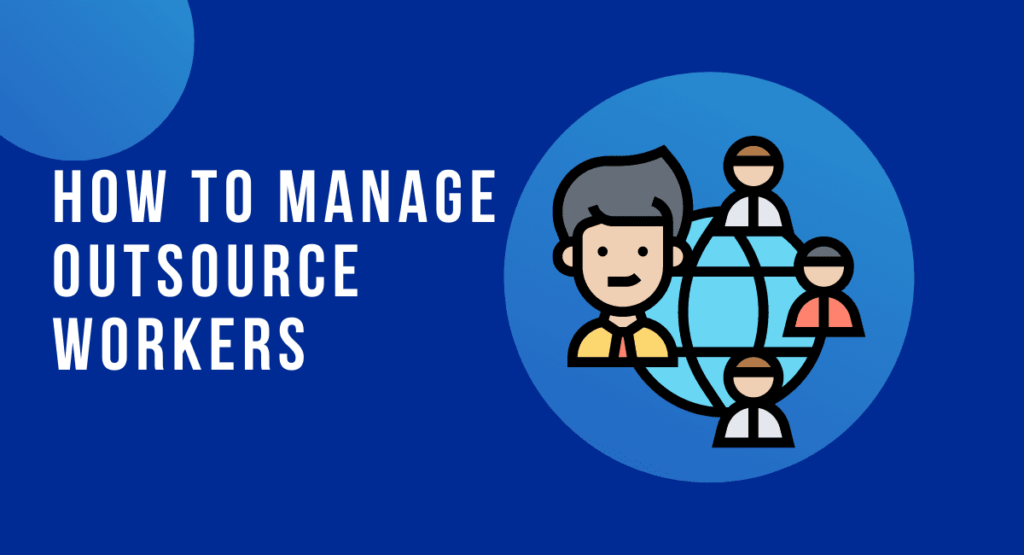How to Manage Outsource Workers


Many businesses outsource specific tasks or projects to reduce costs, time, and risk.
When outsourced effectively, companies can achieve these goals. However, it can be challenging to get back on track when things go wrong.
In this article, we will discuss 13 ways to manage outsourced projects to ensure that you get the best results from your outsourced workers.
Let’s get started!
13 Ways to manage outsource workers and get the best results
“The way you manage your outsourcing arrangements says a lot about your business”. Deloitte.
Outsourcing work is an excellent way to reduce costs while improving efficiency. An outsourced team can lead to greater profitability, stronger brand recognition, and increased market share when managed effectively.
However, even with all the potential benefits of outsourcing, it’s not without its challenges. If you fail to implement an effective strategy when managing your outsourced team, there is a high likelihood that your business will suffer in some way or another.
Common risks include cost overruns, substandard quality or delivery dates, and reduced productivity due to a lack of visibility across multiple locations and teams. There are many ways to manage your outsourced project team and get the best results.
Here are 13 ways to manage outsourced employees:
#1 Build a strong relationship with your outsourcing partners

The first step to a successful outsourced project is building a strong, mutually-beneficial relationship with your outsourcing company. You cannot control what happens on their side, but you can take control of your side.
When outsourcing, you want to select an outsourced team who is just as dedicated to your project’s success as you are.
You want to work with partners suited to your industry, which have the right level of expertise, are flexible enough to adapt as things change, and have a proven track record that demonstrates their ability to deliver on projects as promised.
When it comes to managing your outsourced project team, a strong relationship will pay dividends throughout your project’s lifecycle. It will ensure that you and your partners keep each other informed of progress, challenges, and opportunities and can work together effectively to overcome any issues.
#2 Establish clear communication and transparency requirements
Whether you’ve outsourced IT, HR, or UX/UI tasks, you will want to clarify what level of transparency you expect from your partners. You want to be able to view progress and be kept up to date on the state of play, but at the same time, you don’t want to disrupt your team’s workflow unnecessarily.
You want to set expectations regarding communication and transparency early in the project lifecycle so that both parties understand the boundaries. You may consider using software tools to help manage your outsourcing company.

You and your partners should be able to articulate your project’s end goals clearly. The project team should be able to outline what success looks like, and the business owner should be able to describe their clear expectations.
It is beneficial for all parties to understand what “success” means in terms of your project’s impact, customer experience, and the impact on the bottom line. This will allow everyone to have a consistent approach to project management and provide transparency to enable the team to identify and mitigate risks early on in the project lifecycle.
A shared understanding of end-goal expectations will prevent frustration when project expectations aren’t met. It will also help avoid misunderstandings that may lead to project creep and additional costs.
Get more out of your business
Get the best employee engagement content every week via mailing list
#4 Utilize remote team monitoring tools
Many remote team monitoring tools can help you keep tabs on your remote workers. Some of the most popular ones include Hubstaff, Time Doctor, Rescue Time, and Monitask. When managing remote teams, you want to make sure that you monitor your team’s productivity to some degree.
When managing your outsourced team, there are a few productivity metrics you should be tracking to ensure maximum efficiency.
- Availability.
This metric will tell you how much time employees spend online and working. You can see whether or not your team members are online and available to work at the times they were scheduled to and how much time they spend logged in.
- Productivity.
This metric measures how much work your employees are getting done. You can use productivity metrics to identify bottlenecks, determine if certain team members are under or over-producing, and determine if someone can do anything to improve efficiency.
- Workload.
This metric will determine how many hours of work your team members have available for the current period. By monitoring workload, you can identify if there are any unexpected changes in the commitment that may lead to a reduction in productivity.
#5 Plan the work in advance

When managing your outsourced employees, you want to make sure that the work being completed is well-planned. It would be useful if you had an idea of what has to be done, the time plan, and how much it will cost.
One way to plan the work is by using project management software. This will allow you to create project plans, track progress and stay organized. Planning the work will enable you to manage the target better and identify risks earlier in the project lifecycle. The findings will also highlight any potential bottlenecks, making it simpler to discover solutions to address them.
#6 Define measurable outcomes
When managing your outsourced team, it’s important to define measurable outcomes. Companies want to see the results of their efforts, and success should be easy to measure. This will allow you to identify areas for improvement and make changes as needed to maximize the potential of your project.
When managing outsourced employees, it’s important to define measurable outcomes at the start of the project so that you and your partners are on the same page about success. Doing so will make it easier to track progress and identify challenges early on in the project lifecycle. You should identify areas for improvement and make changes when needed.
#7 Set clear deadlines

Deadlines are important when managing your outsourced employees. Deadlines are helpful because they tell everyone involved in the project when they need to be finished.
They can act as a motivating factor when things get tough, and they can give everyone involved an example in measuring their efforts. When managing your outsourced project team, it’s essential to set clear deadlines for yourself and your partners. This will help to ensure that the project stays on track, and it will help to prevent issues from recurring later on in the project lifecycle.
Setting deadlines for your partners will allow you to keep tabs on them and make sure they stick to their end of the deal. It will also ensure that they apply pressure on their team members to meet the deadlines they’ve been given.
#8 Review Quality Assurance Audits
Suppose your project includes creating new or improved systems, systems of engagement, or workflows. In that case, it’s a good idea to review quality assurance (QA) audits at various stages throughout the project lifecycle.
A QA audit examines an unfinished product or service intended to determine if it meets the project’s quality standards. It’s often conducted by an independent party who is not involved in the project daily. When reviewing QA audits, look for red flags, possible areas for improvement, and recommendations so you can anticipate issues before they become serious problems.
#9 Utilize remote collaboration tools

If your project requires you to engage in collaborative activities with partners, it is essential to use remote collaboration tools. Collaboration tools allow everyone in the organization to work as a team in real-time and from a distance.
The most popular collaboration tools include Slack, Zoom, Cisco WebEx, and GoToMeeting. Most project managers want to use remote collaboration tools as much as possible.
Collaboration software will allow you to collaborate and control partners and team members regardless of where they are located, which will help to increase productivity and improve communication overall.
#10 Manage change effectively
When there are significant disruptions or modifications in operations for whatever reason, good or bad, you’ll want someone who knows how these things work and is handled by professionals.
In business, change is a constant. This is common practice, whether it’s a change in the project requirements or a change in the outsourcing team. Effective change management is essential for success. Here are some tips for managing change effectively:
1. Keep everyone informed of changes as soon as they happen. This includes the outsourcing team, your team, and any other stakeholders.
Change can be difficult to manage, but it’s essential for the success of your project. By keeping employees informed and involving the outsourcing team in change management, you can ensure that changes are made smoothly and effectively.
2. Take the time to understand the changes and their implications. Don’t just assume that you know what’s going on.
It can be easy to assume you understand what’s happening when there are changes to a project. Still, it’s essential to take the time to understand the changes and their implications. This will help you manage the changes more effectively.
#11 Select the right outsourcing partner

When it comes to outsourcing, it’s crucial to select the right partner. There are a lot of remote teams out there, but not all of them are created equal. You want to find a team you can trust to deliver quality work on time and within budget. Some checklist when reviewing a potential outsourcing partner:
- A proven track record. Look for a team that has a proven track record of successful projects. This will give you confidence that they can handle your project effectively.
- Clear communication. Make sure that the team has clear and effective communication channels. This will help avoid misunderstandings and ensure that you’re always on the same page.
- Flexibility. Things change, and you need a flexible team to adapt as needed. Make sure that your potential partner is willing and able to make changes as required.
The right outsourcing partner ensures that your project is in good hands and that outsourcing companies will complete it successfully.
#12 Check-in on the progress of the project regularly
One of the most important ways to manage remote teams is by regularly checking in on their progress. This helps ensure that everyone is on track and met deadlines.
It also provides an opportunity for team members to raise any concerns or issues they may be having. There are a few different ways to check in on remote teams. One is to schedule a regular video or audio conferences. This gives team members a chance to see and hear each other, which can help to build rapport and trust.
And the project management software can help track progress and keep everyone on the same page. Whatever method you choose, regularly checking in on remote teams ensures their success.
#13 Be clear about what you expect

When outsourcing projects, it’s important to be clear about what you expect from the team. This means setting clear objectives and providing detailed instructions.
If the team doesn’t know what you want, they can’t deliver the results you’re looking for. Be sure to provide as much information as possible to outline the tasks that need to be completed.
In addition, it’s essential to set realistic deadlines. This will help to ensure that the team has enough time to complete the work and that you’re not left disappointed.
All requirements for projects or tasks should be clear about what your company expects from the outsource workers. You can avoid misunderstandings and ensure everyone has the same goal. This will help to make sure that the project is completed successfully.
Conclusion
Managing an outsourced team can be risky if you do not have a solid plan. By creating a strategy for managing your outsourcing workers effectively, you can avoid many common risks associated with outsourcing.
Implementing these tips will help ensure that your project stays on track and within budget while maintaining the high-quality standards that your customers expect.


